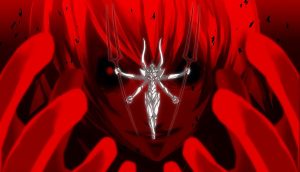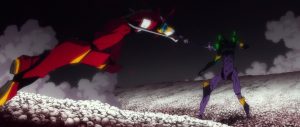
It’s not uncommon for one to watch an episode of Neon Genesis Evangelion and walk away feeling like creator Hideaki Anno has shattered his or her mind and reshaped it—that’s part of what made the series so wildly popular. The constant unveiling of new plot points that viewers couldn’t possibly see coming is charming, refreshing and piques interest. However, in the newest addition to the series of Evangelion remakes, Evangelion: 3.0 You Can (Not) Redo, Anno takes one’s mind out for a cheap dinner date, pushes it off of a cliff, presses a lit cigar against its remains and haphazardly puts the pieces back together with tacky glue. Unfortunately, Anno will likely (Not) ever be able to atone for his sins in making this movie.
Evangelion: 3.0 is the third installment in a series of cinematic remakes of the critically acclaimed 90s animated mech fighting series, Neon Genesis Evangelion. Evangelion: 3.0 was released in the U.S. on Jan. 10. The remakes were released under the premise of being cinematic retellings of the original series. However, Evangelion: 3.0 takes a completely different direction in its storytelling, becoming more of a reimagining of the original series.
Unfortunately, in his quest to breathe new life into the series, Anno has turned it into a hardly recognizable, contrived shadow of its former self. The story has been altered in such a way that it is objectively inferior to that of the original series.
There are almost no similarities between the original series and Evangelion: 3.0, besides the essential giant robot fights, original characters and heavy teen angst.
Despite all this, there are some strong points in Evangelion: 3.0, including the action and the development of inter-character relationships.
Coupled with Anno’s massive new budget for animation, the fighting scenes are nothing short of amazing in Evangelion: 3.0. The color, sound, and detailed perspectives make the fights feel engaging, and induce a tooth-grinding, armrest clawing mixture of anxiety and excitement in the viewers. It’s amazing how a few more million yen can make Asuka punching Shinji in his whiny face look significantly better.

One of the weak points of the original series was the relationships between characters—most screen time that wasn’t devoted to the fight scenes was devoted to one-person, introspective monologues. This was due in large part to the small budget and time constraints that Anno was working with.
While the alterations to the story do not impress, there is something to be said about the relationships and emotions between the characters in Evangelion: 3.0—they feel more realistic and human than they did in the original series. The interactions between characters are given more screen time than in the original series, allowing the viewers to see characters connect on a deeper level.
Despite its massive faults, Evangelion: 3.0 is still a must-see for hardcore Evangelion fans, as the fourth and final cinematic remake will be coming out some time in the near future, and much, albeit stale, plot development happened in 3.0. Evangelion: 3.0 is not recommended to anyone who has not seen either the original series or the first two remakes, unless they care to have their mind violated.






